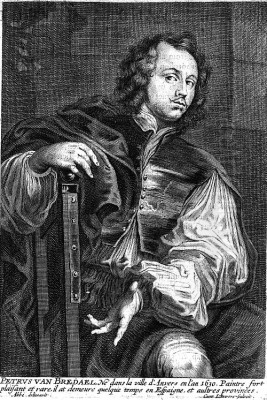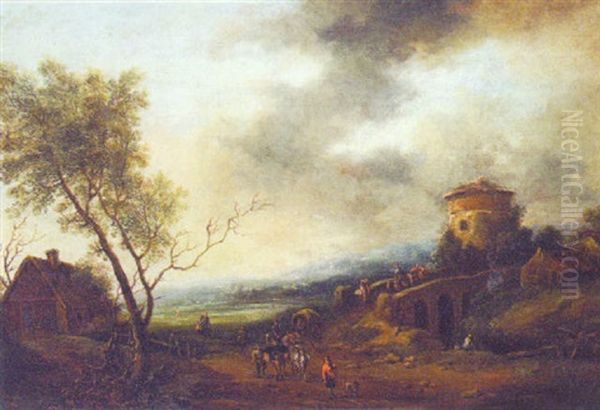
Peeter van Bredael stands as a significant figure in 17th-century Flemish art, an artist whose long career bridged the high Baroque with the early Rococo. Born in Antwerp in 1629 and living until 1719, he witnessed substantial shifts in artistic taste and practice. Bredael carved a distinct niche for himself, becoming particularly renowned for his lively depictions of village fairs, bustling market scenes, and idyllic Italianate landscapes, often populated with numerous figures and animals, showcasing a keen eye for detail and atmosphere.
Antwerp Beginnings and Artistic Formation
Antwerp, during Bredael's formative years, remained a major artistic hub, albeit past the absolute zenith it experienced under Peter Paul Rubens. The city still fostered a vibrant community of artists, guilds, and patrons. It was within this environment that Peeter van Bredael began his artistic journey. Around 1640, he entered the workshop of David Ryckaert III (1612–1661) as an apprentice. Ryckaert himself was a respected painter, known for his genre scenes depicting peasant life, interiors, and allegorical subjects, often with a moralizing undertone.
Studying under Ryckaert would have provided Bredael with a solid foundation in figure drawing, composition, and the techniques of oil painting prevalent in the Flemish tradition. Ryckaert's focus on everyday life likely influenced Bredael's own later predilection for genre subjects, although Bredael would develop a distinct style, often favouring outdoor settings and a brighter, more expansive atmosphere compared to many of Ryckaert's interior scenes.
Entry into the Guild and Professional Recognition
The culmination of an artist's training in Antwerp was acceptance into the Guild of Saint Luke, the venerable institution that regulated the art trade and upheld standards of craftsmanship. Peeter van Bredael achieved the status of 'master' in the Antwerp Guild around 1650 or 1651. This membership was crucial, granting him the right to establish his own workshop, take on apprentices, and sell his works independently.

His standing within the artistic community grew over the decades. A testament to his reputation and administrative capabilities came much later in his career, in 1689, when he was appointed Dean or Director of the Guild (sources use varying titles, but the leadership role is clear). This position signified the high esteem in which his peers held him, not only as a painter but also as a respected member of Antwerp's artistic establishment.
The Allure of Italy: Italianate Landscapes
A defining characteristic of Peeter van Bredael's oeuvre is his engagement with the Italianate style. This trend saw Northern European artists incorporating motifs, light, and atmospheric effects associated with the Italian countryside, particularly the Roman Campagna, into their works. While it's not definitively documented whether Bredael himself travelled to Italy (unlike contemporaries such as Jan Both or Nicolaes Berchem), he masterfully absorbed the style through the works of artists who had, or through prints.
His Italianate landscapes often feature rolling hills, classical ruins serving as picturesque backdrops, meandering rivers, and the warm, golden light characteristic of the Southern European climate. These scenes evoke a sense of pastoral tranquility and nostalgia for classical antiquity. Artists like Johannes Lingelbach (c. 1622–1674) and Anton Goubau (1616–1698), both known for their Italianate market scenes and landscapes often incorporating Roman architectural elements, are frequently cited as influences on Bredael's approach. He skillfully blended Flemish attention to detail with the broader, more idealized vision of the Italianate tradition.
Vibrant Markets and Village Festivities
Perhaps Peeter van Bredael's most characteristic and popular subjects were his depictions of markets and village fairs, known as kermesses. These paintings teem with life, capturing the energy and social interactions of rural and semi-urban communities. He excelled at orchestrating complex compositions filled with numerous figures: merchants hawking their wares, shoppers inspecting goods, farmers tending livestock (horses, cattle, sheep, and goats are common features), children playing, and townspeople conversing.
These scenes are rendered with meticulous care, detailing the textures of fabrics, the variety of goods on display, and the specific activities of the participants. Often, these gatherings are set in village squares, sometimes before a church or near prominent buildings like windmills, or integrated into his Italianate landscapes, perhaps taking place amidst ancient ruins. The colour palette in these works, as noted by observers, sometimes leans towards cooler greys and deep blues, lending a specific atmospheric quality, though warmer tones associated with the Italianate style are also prevalent.
Broader Subject Range: Battles and Landscapes
While best known for markets and Italianate views, Bredael's repertoire extended to other subjects as well. He painted pure landscapes, focusing on the natural environment, sometimes featuring riverscapes or wooded areas, demonstrating his skill in rendering natural forms and atmospheric perspective.
He also produced battle scenes, a genre popular throughout the 17th century, reflecting the frequent military conflicts of the era. These works typically depict cavalry skirmishes or encampments, showcasing his ability to handle dynamic action and group figures in motion. While perhaps not as specialized in this genre as artists like Philips Wouwerman (1619–1668), whose equestrian and battle paintings were highly sought after, Bredael's contributions demonstrate his versatility as a painter capable of tackling diverse themes demanded by the art market of his time.
Commedia dell'Arte and Theatrical Elements
An intriguing aspect mentioned in relation to Bredael's work is his incorporation of figures or scenes related to the Commedia dell'Arte. This form of popular Italian theatre, characterized by stock characters like Harlequin, Pulcinella, and Columbine, improvisation, and masks, captivated audiences across Europe. Several artists, particularly those working in the Rococo period like Antoine Watteau (1684-1721), famously depicted these characters.
Bredael's engagement with Commedia dell'Arte, likely occurring within his Italianate settings, would have added a layer of theatricality and narrative interest to his paintings. Depicting these masked performers amidst a market scene or a pastoral landscape created a fascinating juxtaposition of everyday life and staged entertainment, reflecting the cultural interests of the period and showcasing Bredael's ability to integrate diverse elements into his compositions. Artists like Karel Dujardin (1626–1678) also sometimes included such theatrical elements in Italianate scenes.
Travels and Professional Network
Sources indicate that Peeter van Bredael's professional life wasn't confined solely to Antwerp. He is recorded as having worked in Spain for a period, although specific dates and locations remain elusive. Such travel would have exposed him to different artistic traditions and patronage systems. He also worked in the Netherlands, likely maintaining connections fostered during his apprenticeship years or through the general artistic exchange between the Northern and Southern Netherlands.
While direct records of his interactions with many specific contemporary painters outside his family and teacher are scarce, his long career, prominent position in the Guild, and the nature of the Antwerp art world suggest he was undoubtedly part of a network of artists, dealers, and patrons. His work was known, and sometimes, as noted in sources, even misattributed to other artists like the Dutch painter Pieter Snijders, indicating a similarity in style or subject matter that could cause confusion in the market.
Notable Works
Identifying specific masterpieces can be challenging without a complete catalogue raisonné, but several works are consistently associated with Peeter van Bredael and exemplify his style:
Market Scene and Classical Landscape: This title perfectly encapsulates his signature blend. A painting with this description, noted as measuring 81x113 cm and bearing his signature in the lower left, would likely feature a lively market in the foreground set against a backdrop of idealized landscape with Roman-inspired ruins, showcasing his compositional skill and thematic focus.
Kermesse near a Town with a Windmill and Kermesse in Front of a Church: These titles point to his popular village festival scenes. They would depict bustling crowds engaged in celebration, eating, drinking, and dancing, set within recognizable Flemish village environments, rendered with his characteristic attention to detail and vibrant energy.
Great Genre Scene: Often described as depicting a rural market set amidst ancient ruins, this again highlights his fusion of Northern genre realism with Southern classical settings.
Across these works, one typically finds carefully rendered figures, a skillful handling of light to create depth and atmosphere, and a narrative quality that invites viewers to explore the various activities unfolding within the scene.
The Bredael Artistic Dynasty
Peeter van Bredael was not only a successful artist in his own right but also the patriarch of a notable artistic dynasty that continued his legacy into the 18th century. Several of his sons and grandsons became accomplished painters, often working in styles related to his own or specializing in particular niches.
His son, Joris van Bredael (1661–c. 1706), followed in his father's footsteps as a painter in Antwerp and was also active in the Guild of Saint Luke.
Another son, Alexander van Bredael (1663–1720), was also a painter, known for Italianate landscapes and market scenes, continuing the family tradition. He often depicted harbours and Mediterranean settings.
The next generation produced perhaps the most well-known of his descendants:
Jan Frans van Bredael (1686–1750), son of Joris. He achieved considerable success, particularly noted for his skillful imitations and pastiches of the works of Philips Wouwerman and Jan Brueghel the Elder ('Velvet Brueghel'). His battle scenes, landscapes, and elegant gatherings were finely executed and highly popular. He spent time working successfully in England before returning to Antwerp.
Joseph van Bredael (1688–1739), also a son of Joris. He specialized almost exclusively in creating works in the meticulous, jewel-like style of Jan Brueghel the Elder (1568–1625) and his son Jan Brueghel the Younger (1601–1678). Joseph worked for a period for the Antwerp art dealer J. de Witte, producing high-quality copies and variations of Brueghel compositions, which were in great demand throughout the 18th century. His ability to capture the detailed brushwork and vibrant colours of the Brueghels was remarkable.
This family enterprise demonstrates the transmission of artistic skills and styles across generations, a common feature of the early modern art world. The Bredael family, starting with Peeter, made a lasting contribution to Flemish art, particularly in landscape and genre painting.
Later Years and Lasting Legacy
Peeter van Bredael lived an exceptionally long life for his era, dying in Antwerp in 1719 at the age of 90. He remained active as an artist for much of his life, adapting perhaps to changing tastes while maintaining the core elements of his established style. His legacy lies in his prolific output of attractive and skillfully executed paintings that catered to the tastes of the burgeoning middle-class market as well as aristocratic patrons.
He successfully synthesized Flemish traditions of detailed genre painting with the fashionable Italianate style, creating works that were both descriptive and idealized. While not an innovator on the scale of giants like Rubens or Rembrandt van Rijn (1606-1669), nor possessing the earthy immediacy of genre painters like David Teniers the Younger (1610-1690), Peeter van Bredael holds a secure place as a master craftsman and a key figure in Antwerp painting of the later 17th century. His influence extended through his own works and significantly through the successful careers of his descendants, who carried the Bredael name forward in the art world.
Conclusion
Peeter van Bredael remains a respected figure in the history of Flemish Baroque art. His paintings offer a window into the life and aesthetic preferences of the 17th and early 18th centuries. Through his detailed market scenes, lively kermesses, and serene Italianate landscapes, often enlivened by elements of classical antiquity or popular theatre, he created a body of work characterized by technical skill, careful observation, and considerable charm. As the founder of an artistic dynasty, his impact resonated beyond his own lifetime, contributing significantly to the enduring tradition of Flemish painting. His works continue to be appreciated in museums and collections worldwide for their craftsmanship and engaging depictions of a bygone era.